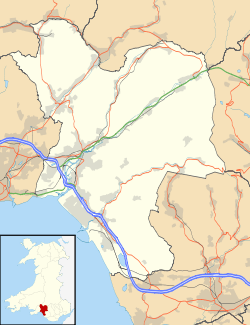Gwaun-Cae-Gurwen
| Gwaun-Cae-Gurwen | |
| Welsh: Gwauncaegurwen | |
 |
|
 Gwaun-Cae-Gurwen |
|
| Population | 4,240 (2011)[1] |
|---|---|
| OS grid reference | SN705115 |
| Principal area | Neath Port Talbot |
| Ceremonial county | West Glamorgan |
| Country | Wales |
| Sovereign state | United Kingdom |
| Post town | AMMANFORD |
| Postcode district | SA18 |
| Dialling code | 01269 |
| Police | South Wales |
| Fire | Mid and West Wales |
| Ambulance | Welsh |
| EU Parliament | Wales |
| UK Parliament | Neath |
| Welsh Assembly | Neath |
|
|
Coordinates: 51°47′14″N 3°52′44″W / 51.787125°N 3.878898°W
Gwaun-Cae-Gurwen (Welsh: Gwauncaegurwen) is a village in Neath Port Talbot, South West Wales. Gwaun-Cae-Gurwen is a parish made up of the electoral wards of Gwaun-Cae-Gurwen and Lower Brynamman.
Location
Gwaun-Cae-Gurwen is located five mile east of the nearest town of Ammanford and nearly twenty miles north of Swansea. Nearby villages include Cwmgors, Brynamman, Tairgwaith, Glanaman and Garnant.
Etymology
The name Gwaun-Cae-Gurwen is believed to be an alteration of what was originally gwaun cegerwen (i.e. "white hemlock heath" in Welsh, ceger being a dialect form of cegid).[2] In local usage, the name is often shortened to "Y Waun" or simply "GCG".
Schools
Ysgol Gynradd Gymraeg Gwauncaegurwen (Gwaun-cae-Gurwen Welsh Primary School) used to be on Heol y Dŵr (Water Street) which is where the Pwll y Wrach estate is based. It has since been moved to Heol Newydd (New Road), overlooking the village, and the former school transformed into a wood workshop.
Secondary-age children in the area have the choice of going to Ysgol Gyfun Ystalyfera in Ystalyfera (for full Welsh-medium education),[3] Ysgol Dyffryn Aman (for Welsh- and English-medium education),[4] or Cwmtawe Community School (for English-medium education).[5]
Welsh language
The Welsh language is very strong in Gwaun-Cae-Gurwen, with the highest proportion of Welsh-speakers being among the young. The Welsh Language Board reported in 2009 that:
- In areas such as Gwaun Cae Gurwen (67.9%) and Brynaman Isaf (68%) [...] Welsh is a natural community language spoken in the street, in cafés and amongst third sector organisations. Perhaps the most notable fact is that the highest percentage of Welsh speakers is amongst 10–19 year olds.[6]
Representation
As of 2014 the area was represented in the House of Commons by Peter Hain, and in the National Assembly for Wales by Gwenda Thomas, who lives in the village; they both represent the Neath constituency. Its South Wales West regional assembly members are Suzy Davies and Henry Byron Davies (Welsh Conservatives), Bethan Jenkins (Plaid Cymru), and Peter Black (Welsh Liberal Democrats). It has a Community Council.
The electoral ward mentioned above has a population taken at the 2011 census of 2,910.[7]
Sport
Cwmgors RFC play their home games at Parc-y-werin, Gwaun-Cae-Gurwen. Their clubhouse is also situated at New Road, Gwaun-Cae-Gurwen.
Notable natives
- Sir Gareth Edwards, former Wales and British and Irish Lions player; a street, Maes Gareth Edwards, is named after him
- Dame Siân Phillips, actress
- Barry Morgan, Archbishop of Wales and Bishop of Llandaff
- Lizzie Woods, National Organiser, Labour Representation Committee and leader of the dispute to award cleaners working in royal palaces the London Living Wage
Pwll-y-Wrach
At one time, almost all of the land of The Waun was owned by the Jones Family who also owned the "Pwll-y-Wrach Estate". It was run by the Head and later by their sons (and spouses). They still own parts of the land of the village but most has been sold off. Both farmhouses connected to the Estate are still standing. They are: Pwll-y-Wrach and Glangwrach. Pwll y Wrach is the main house where the head of the family lived.
It is no longer a farming estate but remains to own much of the land in the village. The name means the Witch's Pool in English, because of an old Welsh myth that the witches lived in it because of the greeny-blue colour and would sometimes come out to haunt the locals.
References
- ↑ "Community population 2011". Retrieved 12 April 2015.
- ↑ Cwmgors a'r Waun local history website
- ↑ Ysgol Gyfun Ystalyfera website
- ↑ Ysgol Dyffryn Aman website
- ↑ Ysgol Gymunedol Cwmtawe website
- ↑ Bwrdd yr Iaith Gymraeg / Welsh Language Board
- ↑ "Ward population 2011". Retrieved 12 April 2015.
External links
- GCG and Cwmgors Genealogy Help Page by Gareth Hicks
- www.geograph.co.uk : photos of Gwaun-Cae-Gurwen and surrounding area
- Gwaun Cae Gurwen Community Council website